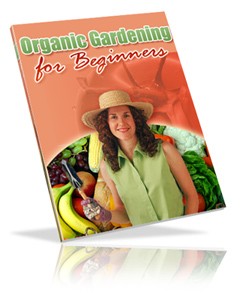 License Type: Private Label Rights
License Type: Private Label Rights  File Size: 4,119 KB
File Size: 4,119 KB File Type: ZIP
File Type: ZIP
 SKU: 22899
SKU: 22899  Shipping: Online Download
Shipping: Online Download
Ebook Sample Content Preview:
You’ve spent quite a bit time and effort to make sure your garden is laid out in the most promising way and considering how best to grow that garden organically. Now you need to take care of your plot.
Plants need light and water to grow. The light is already taken care of by Mother Nature; you have to take care of the water!
Watering the garden every evening after dinner can be good therapy for the gardener, but it's not good for the plants. When the soil is often sprinkled on top but never deeply soaked, plant roots tend to remain in the damp, upper few inches of soil where they are vulnerable to searing mid-summer heat and drought. Vegetable plants need an average of 2-inches of water a week. Be sure to water thoroughly so the soil is soaked to a depth of 4 to 6-inches. This will encourage roots to grow deep.
Germinating seeds and seedlings need to be kept uniformly moist without being washed away, so water them with a gentle spray every day or two. Developing plants need to be watered deeply, but less often, to encourage deep root growth. Water to a depth of at least 6 inches and then let the surface inch or two completely dry out before watering again.
As a general guideline, garden plants that have been watered properly, and therefore have developed deep roots, need a thorough watering every 5 to 7 days in hot weather.
Hand watering delivers water directly to the plants, thus eliminating waste, but it takes time. Spot check to make sure you are delivering enough water, and be careful to give all areas of the garden adequate coverage.
Sprinklers have the disadvantage of wasting water by watering paths and other open spots in the garden. They also lose water to evaporation and wind drift. Because they wet the foliage, sprinklers also can promote the development of leaf diseases.
However, sprinklers are easier and eliminate the need to stand outside holding a hose for 20 minutes - especially if you have a large garden.
If you use oscillating sprinklers, elevate them above the tallest plants so the water streams are not blocked. To make sure all of your plants are watered, place sprinklers so their patterns overlap. Runoff indicates you need to water at a slower rate.
You can also consider taking a simple garden hose and making your own irrigation system by poking holes in the top of it at uniform angles. Simply place this hose between the rows of plants and move when the watering is done in that particular section.
You should generally water your garden in the early evening when it is cooler. This will reduce the chance of evaporation from the hot sun and heat. Early morning watering is fine, but less effective.
Be wary of over-watering your garden. This can cause your plants to be less successful and produce disappointing yields. Generally, the first few weeks after planting and transplanting and during the development of fruit or storage organs are times when plants may be adversely affected by shortages of water, so water plentifully during these times.
Obviously, Mother Nature will provide you with some of her water as well. Monitor your rain levels and check to be sure that your garden has enough moisture if it has rained to see if you need to add to it.
Healthy plants that produce a wealth of healthy food can get a well needed boost from some type of fertilizer. Composting can provide this, but there are other ways to fertilize.
- File Size:4,119 KB
- License: Private Label Rights
- Category:Ebooks
- Tags:2010 Ebooks Private Label Rights








